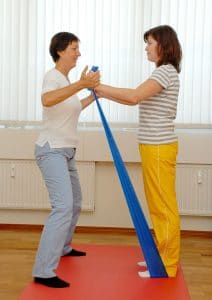Treatment of Spondylolisthesis at MVZ Dr. Schneiderhan in Munich
In so-called spondylolisthesis one or several vertebral bodies, mostly in the region of the lower lumbar spine, are displaced against each other. This is often caused by excessive strain during over-extension of the upper body during certain sports.
What is spondylolisthesis?
In spondylolisthesis, one or several vertebra slip against each other. The reason for this is wear of the bones between the joints of the spine which connect the adjacent vertebrae of our spine with each other and determine the direction of movement. Excessive strain first forms a crack, medically known as spondylolysis, in the vertebral arch at the back of the vertebral body, through which the spinal cord also runs. This crack formation primarily affects the lowest (fifth) vertebra of the lumbar spine; it affects the fourth vertebra with the second-most frequency and in rare cases, also the cervical or thoracic vertebrae. In approximately half of spondylolysis patients, the affected vertebrae then press against each other over the course of time. The upper vertebral body slips forward on top of the lower one (in the direction of the stomach).
What causes spondylolisthesis?

Medical graphics: Joint pain
The precursor stage of spondylolisthesis, known as spondylolysis (crack in the vertebral arch), often occurs with certain sports in which the spine is intensely stretched. These include gymnastics, trampolining, pole vault or other throwing disciplines. But the ageing process (a degenerative form of spondylolisthesis) or genetic predisposition can also cause the disease. Injuries, inflammation or tumours can also be triggers of spondylolisthesis but are much rarer. Age-related degenerative changes of the intervertebral discs can also cause displacement of the vertebrae, even without spondylolysis.
What are the symptoms of spondylolisthesis?
In the early stages, spondylolisthesis causes pain on movement; in rare cases, it can lead to trapped or stretched nerves in the spinal canal and thereby to disturbance of sensitivity or paralysis. The crack formation does not usually cause pain however non-specific back pain can also occur. Spondylolisthesis can also develop gradually and initially without symptoms for those affected. This also occurs if the nerve fibres have enough time to “simultaneously extend”, which is why there are usually hardly symptoms.
Orthopaedic specialists differentiate between different severity stages of spondylolisthesis when making a diagnosis:
Severity stage – Misalignment in % – Description
Stage 1 < 25 % The upper vertebral body covers three quarters of the lower vertebral body
Stage 2 25 – 50 % The upper vertebral body covers half and less than three quarters of the lower vertebral body
Stage 3 50 – 75 % The upper vertebral body covers a quarter and less than half the lower vertebral body
Stage 4 < 75 % The upper vertebral body covers less than a quarter of the lower vertebral body
How is spondylolisthesis treated?

Magnetic resonance imaging for spondylolisthesis
X-ray and magnetic resonance imaging of the spine usually clearly reveal spondylolisthesis, help us to estimate its severity and to select the best possible treatment for you. We carry out these examinations in our interdisciplinary group practice on the day of your visit, thereby saving you further follow-up appointments. The aim of the treatment is to alleviate pain, eliminate any neurological symptoms and prevent the illness from progressing.
Treatment for spondylolisthesis is normally conservative. After a comprehensive analysis and diagnosis, we recommend a treatment concept specially tailored to your needs. This includes physiotherapy as well as pain-relieving medication that can also be injected directly into the affected nerve root in the case of acute symptoms. Physiotherapy helps to stabilize the spine by training specific muscle groups and the pain therapy prevents patients from adopting a relieving posture which usually makes the back pain worse.

Treatment example: Physiotherapy for patients

Treatment example: Injection into the neck
If the symptoms are not alleviated despite conservative treatment, minimally-invasive methods or, as a final option, surgical treatment, may be necessary. The treatment concept is always individually tailored to your needs. Whether conservative treatment or an operation is recommended, not only the cause, type and severity of the spondylolisthesis and the symptoms are taken into consideration but also the age of the patient (a possible degenerative form of spondylolisthesis), physical activity, the condition of the intervertebral discs and the vertebral body bordering them.
Tips for spondylolisthesis sufferers: These exercises help
If you have spondylolisthesis, pain can develop when a shortened muscle exerts a strong pull on the vertebra. You can relieve these symptoms with targeted exercises:
Exercise 1:
Adopt an all-fours position on a mat. Now stretch your legs out to the rear, putting the bridge of your feet on the floor. Stretch your arms out and place your palms on the floor. Your wrist and shoulder should form a line. Let your back hang down and your hips sink in the direction of the floor. Do not worry if you now feel pain in your back. That is a sign that you are doing the exercise properly. In this way, you are removing the pull from the vertebra that has shifted forward and the surrounding muscles can relax.
Variation: Take up the basic position of the first exercise but now bend one leg out to the side and put your foot on the inside of the knee of the other leg. Now try again more intensely to let your right hip hang down. Then change sides
Hold exercise 1 and the variation for two to three minutes.
Exercise 2:
Adopt an all-fours position on a mat and lay a fascia roller in front of your knee. Now adopt the position from exercise 1 with stretched knees again until your thighs are lying on the roller. Relax and adopt a comfortable position. As your thighs are now lying higher, your hips can hang down even more.
Variation: Lay only one thigh on the roller. Doing this means that you can feel the pull more strongly on one side and the affected side can hang down even more.


We are here for you!
jameda review from 12/2018
Wiltrud Rakel, OP spinal canal stenosis, 2018.
"A competent and very confident statement at diagnosis, "golden hands" at surgery WS canal stenosis. Thank you Dr. Hadi for a new pain free life.
Your Wiltrud Rakel"






